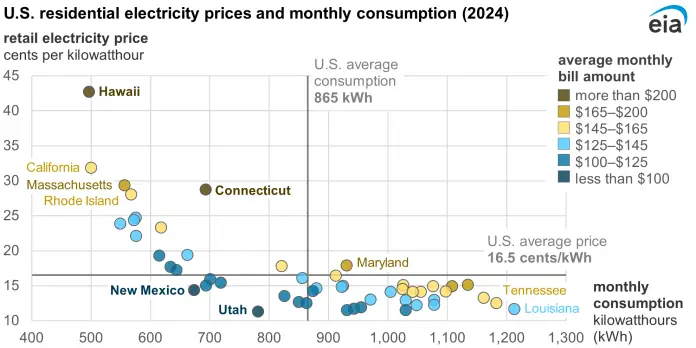The latest analysis from the U.S. Energy Information Administration (EIA) has unveiled critical insights regarding residential electricity costs across the nation, revealing significant disparities that small business owners must consider as they navigate operational expenses and budgeting.
In 2024, the average monthly electric bill for U.S. residential customers reached $144, a slight increase from the previous year. However, there are vast differences among states. For instance, residents in Hawaii faced some of the steepest monthly costs, averaging over $200, while those in Utah experienced the opposite end of the spectrum with bills nearing $89. This variability highlights an essential consideration for small business owners who may find electricity costs impacting their bottom lines.
According to the EIA, multiple factors drive these differences in electricity prices, including retail rates and the total amount of electricity consumed. The national average residential electricity price rose from 16.0 cents per kilowatt-hour (kWh) in 2023 to 16.5 cents/kWh in 2024. Monthly consumption also saw a 2% increase from the previous year, averaging 865 kWh per customer.
Small business owners should pay attention to these figures for several reasons. For those in high-cost regions, such as Hawaii or Connecticut, understanding how elevated energy prices affect operational expenses can help in strategizing pricing and budget allocations. “Every dollar saved in overhead can improve profit margins, so it’s vital for business owners to continually seek efficiencies,” said an EIA analyst.
Are you considering the implementation of energy-efficient solutions? The EIA’s data highlights that high electricity prices often correlate with states depending on costly energy sources. In Hawaii, for instance, the predominance of petroleum-fired generators significantly drives prices upward. On the other hand, states like Utah and New Mexico benefit from lower costs due to their reliance on cheaper coal and natural gas.
Furthermore, small businesses specializing in energy efficiency products or services may find opportunities to expand their clientele by targeting states with the highest energy costs. An uptick in efficient appliances, solar installations, and other energy-saving technologies could be a selling point for local utility companies looking to promote sustainability.
However, in regions where electricity consumption is higher due to climate factors, like Louisiana’s heavy reliance on air conditioning, small business owners must also consider how weather patterns affect energy consumption. Louisiana had the highest average electricity consumption among residents, which could reflect increased operational costs for businesses reliant on climate control systems. “Understanding peak usage hours and addressing energy consumption can lead to better management of energy costs,” the analyst noted.
Small business owners exploring renewable energy options should be aware that many states are beginning to offer incentives for solar and other energy-saving installations. States like Hawaii, despite their high costs, often have significant solar adoption. However, they must navigate the initial investment costs and the complexity of integrating solar into their existing energy setups.
Potential challenges for small business owners include understanding the nuances of utility billing practices and keeping pace with fluctuating energy prices. Many utility companies adjust usage rates seasonally, which can complicate budgeting.
In summary, with electricity bills showing marked differences across states and an overall increase nationwide, small business owners must remain vigilant and proactive. Evaluating energy options, understanding consumption patterns, and possibly transitioning to renewable energy solutions can empower owners to mitigate these rising costs effectively. Keeping informed about the energy landscape will be crucial as you plan for the operational year ahead.
For further details and insights, you can access the full report from the EIA here.
Image Via US Energy



